外研版(2019)选择性必修 第二册Unit 6 Survival Understanding ideas 课件(共19张PPT)
文档属性
| 名称 | 外研版(2019)选择性必修 第二册Unit 6 Survival Understanding ideas 课件(共19张PPT) |  | |
| 格式 | pptx | ||
| 文件大小 | 11.2MB | ||
| 资源类型 | 教案 | ||
| 版本资源 | 外研版(2019) | ||
| 科目 | 英语 | ||
| 更新时间 | 2023-03-13 12:59:13 | ||
图片预览

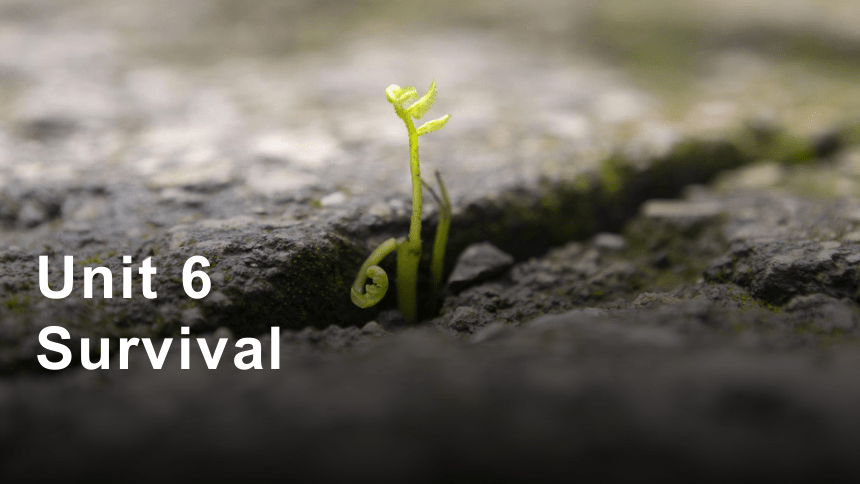
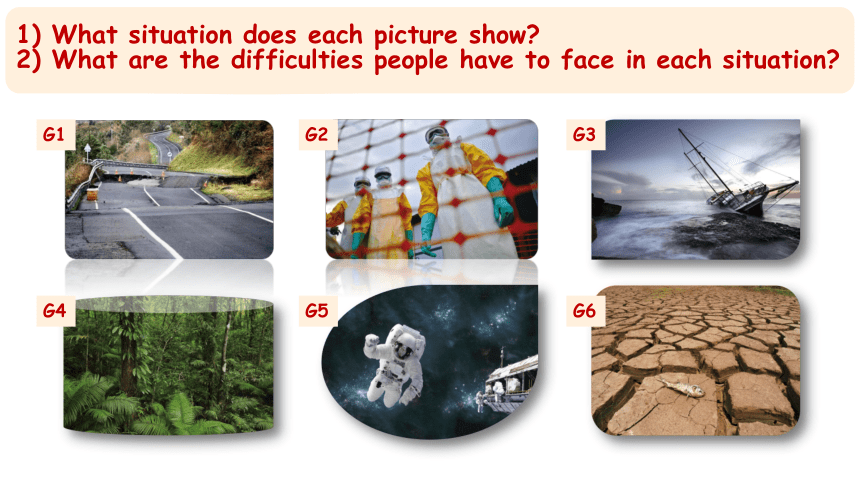
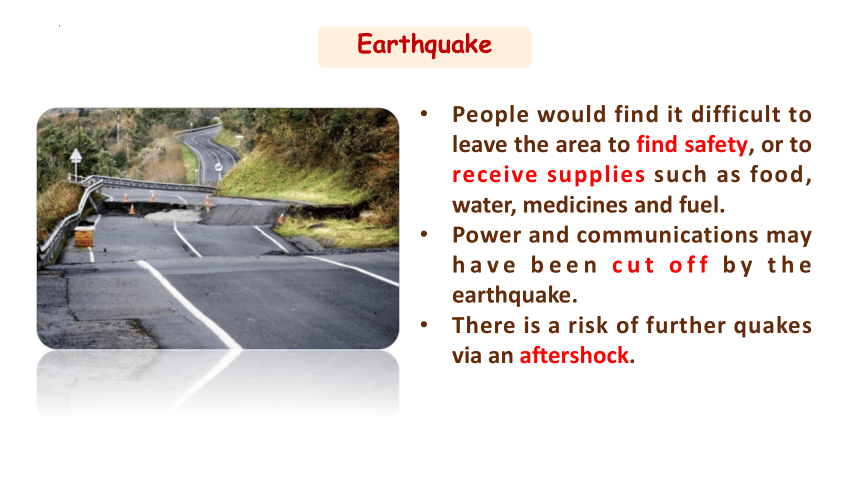
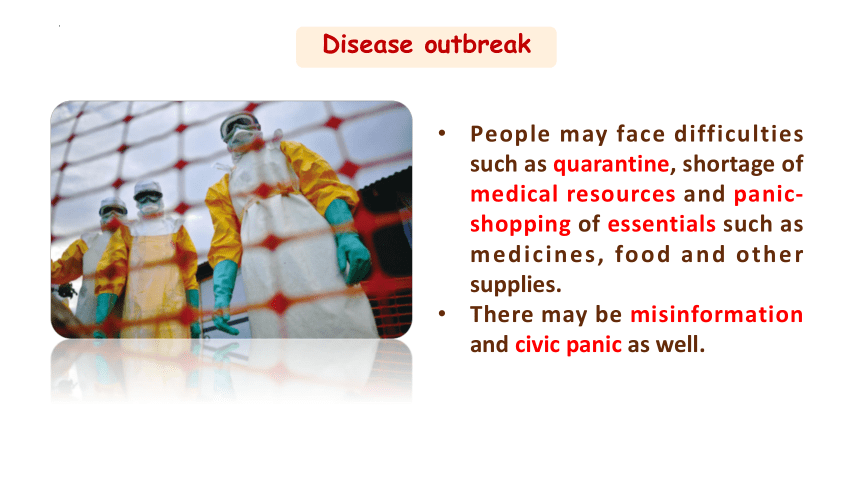
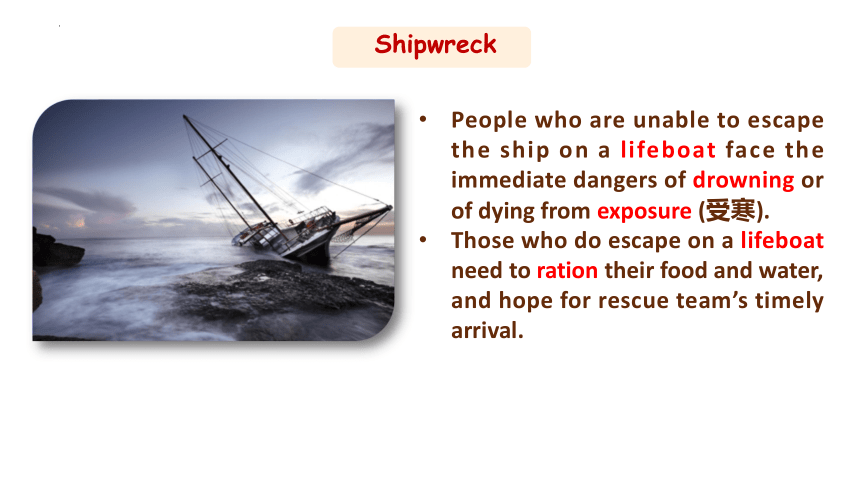
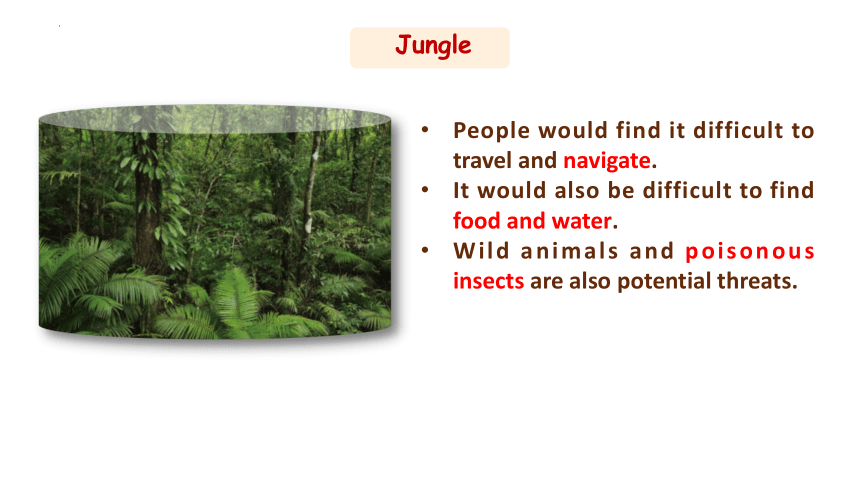
文档简介
(共19张PPT)
Unit 6
Survival
1) What situation does each picture show
2) What are the difficulties people have to face in each situation
G1
G2
G3
G4
G5
G6
People would find it difficult to leave the area to find safety, or to receive supplies such as food, water, medicines and fuel.
Power and communications may have been cut off by the earthquake.
There is a risk of further quakes via an aftershock.
Earthquake
People may face difficulties such as quarantine, shortage of medical resources and panic-shopping of essentials such as medicines, food and other supplies.
There may be misinformation and civic panic as well.
Disease outbreak
People who are unable to escape the ship on a lifeboat face the immediate dangers of drowning or of dying from exposure (受寒).
Those who do escape on a lifeboat need to ration their food and water, and hope for rescue team’s timely arrival.
Shipwreck
People would find it difficult to travel and navigate.
It would also be difficult to find food and water.
Wild animals and poisonous insects are also potential threats.
Jungle
They face danger from extreme temperatures, low pressures and various radiations.
The lack of gravity makes simple actions such as eating, drinking, moving and even sleeping difficult.
Anyone who spends too long in a zero-gravity environment risks losing bone and muscle mass.
Outerspace
Without water, people and livestock face death within a short period of time.
In addition to water shortages, drought causes crop failure, so people would face food shortage as well, which could affect people who do not live in the drought-affected area.
Severe food shortages can cause famine, migration, collapse of social stability and even war.
Drought
The crime took place in a seaside suburb of Cape Town. Spotting the car with its window left open, the greedy thief didn’t hesitate. Within seconds, he had reached inside and run away with a bag of shopping. No matter how many crimes he committed, the police were powerless to arrest him…
This was no ordinary criminal:
it was a chacma baboon (豚尾狒狒).
Who could be the criminal
Chacma baboon
Height: 1.15 m
Weight: 15-31 kg
Habitat: throughout southern africa
Life span: 15-20 years
Think & share
Why would the animals enter and live in the cities
What problems could they encounter in cities
Is there any benefit of living in the cities
Fast reading
Match the topic sentences to the paragraphs.
One thing crucial to the increasing number of “urban animals” is their ability to adapt.
People often wonder about the reasons behind this mass urban migration.
For those animals that don’t adapt, the city can be a dangerous or even deadly place.
Yet, for its newest and wildest inhabitants, a city can offer many benefits.
Paragraph 2
Paragraph 3
Paragraph 4
Paragraph 5
Detailed reading
Find out the detailed information and summarise them with key words.
wildlife taking over cities
reasons
benefits
adaption
problems
attitudes
The
Wild
Within
urban development
climate change
habitat loss
appealing spaces
absence of predators
sufficient food
becoming more intelligent
changing living habits
window impacts
understanding/appreciating/sharing
What are the qualities of successful urban wildlife survivors
Critical thinking
Resourceful
Intelligent
Adaptable
What can we do to achieve a balance between the need for urban development and the protection of wild animals
Critical thinking
Make laws to protect the wild and their habitats /plan urban construction wisely /set up more natural habitats/ provide enough shelter and food / educate people…
Raise awareness of environmental protection/ obey the laws/ plant trees/ respect and protect the animals…
Unit 6
Survival
1) What situation does each picture show
2) What are the difficulties people have to face in each situation
G1
G2
G3
G4
G5
G6
People would find it difficult to leave the area to find safety, or to receive supplies such as food, water, medicines and fuel.
Power and communications may have been cut off by the earthquake.
There is a risk of further quakes via an aftershock.
Earthquake
People may face difficulties such as quarantine, shortage of medical resources and panic-shopping of essentials such as medicines, food and other supplies.
There may be misinformation and civic panic as well.
Disease outbreak
People who are unable to escape the ship on a lifeboat face the immediate dangers of drowning or of dying from exposure (受寒).
Those who do escape on a lifeboat need to ration their food and water, and hope for rescue team’s timely arrival.
Shipwreck
People would find it difficult to travel and navigate.
It would also be difficult to find food and water.
Wild animals and poisonous insects are also potential threats.
Jungle
They face danger from extreme temperatures, low pressures and various radiations.
The lack of gravity makes simple actions such as eating, drinking, moving and even sleeping difficult.
Anyone who spends too long in a zero-gravity environment risks losing bone and muscle mass.
Outerspace
Without water, people and livestock face death within a short period of time.
In addition to water shortages, drought causes crop failure, so people would face food shortage as well, which could affect people who do not live in the drought-affected area.
Severe food shortages can cause famine, migration, collapse of social stability and even war.
Drought
The crime took place in a seaside suburb of Cape Town. Spotting the car with its window left open, the greedy thief didn’t hesitate. Within seconds, he had reached inside and run away with a bag of shopping. No matter how many crimes he committed, the police were powerless to arrest him…
This was no ordinary criminal:
it was a chacma baboon (豚尾狒狒).
Who could be the criminal
Chacma baboon
Height: 1.15 m
Weight: 15-31 kg
Habitat: throughout southern africa
Life span: 15-20 years
Think & share
Why would the animals enter and live in the cities
What problems could they encounter in cities
Is there any benefit of living in the cities
Fast reading
Match the topic sentences to the paragraphs.
One thing crucial to the increasing number of “urban animals” is their ability to adapt.
People often wonder about the reasons behind this mass urban migration.
For those animals that don’t adapt, the city can be a dangerous or even deadly place.
Yet, for its newest and wildest inhabitants, a city can offer many benefits.
Paragraph 2
Paragraph 3
Paragraph 4
Paragraph 5
Detailed reading
Find out the detailed information and summarise them with key words.
wildlife taking over cities
reasons
benefits
adaption
problems
attitudes
The
Wild
Within
urban development
climate change
habitat loss
appealing spaces
absence of predators
sufficient food
becoming more intelligent
changing living habits
window impacts
understanding/appreciating/sharing
What are the qualities of successful urban wildlife survivors
Critical thinking
Resourceful
Intelligent
Adaptable
What can we do to achieve a balance between the need for urban development and the protection of wild animals
Critical thinking
Make laws to protect the wild and their habitats /plan urban construction wisely /set up more natural habitats/ provide enough shelter and food / educate people…
Raise awareness of environmental protection/ obey the laws/ plant trees/ respect and protect the animals…
